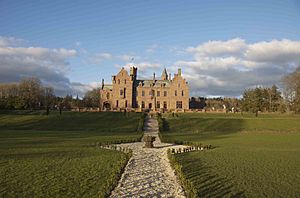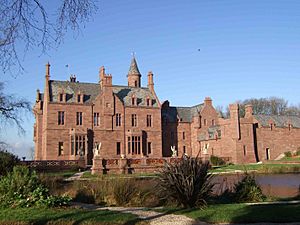Castle Oliver facts for kids
Castle Oliver (also known as Clonodfoy) is a beautiful Victorian castle located in the southern part of County Limerick, Ireland. Unlike older castles built for fighting, Castle Oliver was designed for fun and entertaining guests. It has many grand rooms like a ballroom, drawing room, library, and dining room. These rooms feature amazing hand-painted ceilings, fancy decorations, and stunning stained glass windows.
The castle sits on huge terraces, offering a great view of its former 20,000-acre estate. It also has Ireland's biggest wine cellar, which is said to hold about 55,000 bottles! In 2014, Castle Oliver was open to the public for tours as part of the "Limerick City of Culture" event.
A Look Back: Castle Oliver's History
The land where Castle Oliver stands was first settled around 1658 by Captain Robert Oliver. He was a soldier who served Oliver Cromwell. The current castle replaced an older one that was about a thousand yards away. That older castle was the birthplace of Eliza Oliver, whose daughter, Lola Montez, became a famous dancer known for her connection to King Ludwig I of Bavaria.
For many years, the castle was called Clonodfoy. This name comes from an old Irish name, Cloch an Otbhaidhigh, which means 'the stone building of Otway'. Otway was an old Anglo-Norman family name.
The Artistic Sisters
Captain Robert Oliver's descendant, Richard Oliver, married a wealthy woman from Yorkshire, England. He inherited a lot of money and property there, so he moved to Parlington Hall near Leeds. Castle Oliver was left to slowly fall apart, managed by a caretaker.
Richard's daughters, Mary Isabella and Elizabeth Oliver Gascoigne, were very talented artists. They both married members of the Trench family from Woodlawn, Galway. Elizabeth married Frederic Mason Trench, 2nd Baron Ashtown in 1852. The sisters designed and created the beautiful stained glass and special back painted glass panels (called verre eglomise) that decorated the ballroom fireplace. Much of their amazing work can still be seen today. Mary Isabella was also a very skilled wood-turner. She even wrote an important book on the subject, "The Art of Wood-Turning," which is still respected today.
The sisters decided to build the current castle in 1845. They hired an architect named George Fowler Jones from York. He designed the castle in the Scottish Baronial style, which looks like old Scottish castles. It was built using local pink sandstone found on the estate. Fowler Jones had designed other buildings for the sisters in northern England, including churches.
While Mary Isabella and her husband lived at Parlington Hall in Yorkshire, Elizabeth and her husband lived at Castle Oliver. Later, Elizabeth's step-grandson, William Cosby Trench, inherited the house.
New Owners and Restoration
The last member of the Trench family to live at Castle Oliver was Mrs. Lynn Trench. She sold the castle in 1978 to a racing driver named Billy Coleman. After that, the castle was sold several times. It eventually became the property of a local bank, which sold off the land and other buildings separately. The castle itself struggled to find a buyer and began to decay. It was damaged by vandals and thieves. The castle even appeared in a book called "Vanishing Houses of Ireland," which showed important Irish homes that were disappearing.
In 1988, Damian Haughton bought the castle. He helped stop the worst leaks in the roof. Then, in 1998, Nicholas Browne purchased it. He continued the restoration work and made it a comfortable home again. In 2006, Declan and Emma Cormack from County Antrim bought Castle Oliver. They did a lot of high-quality restoration work, bringing many of the original rooms and features back to life. This included the Library, the St. Patrick's stained glass window, wooden panels, and many fireplaces. The Cormacks lived in the castle with their three children. In 2015, they sold it to a family from Melbourne, Australia, who planned to use it as a home for part of the year.





